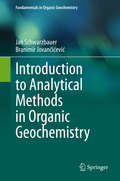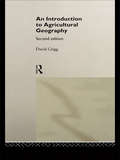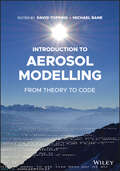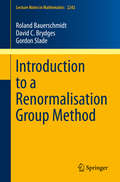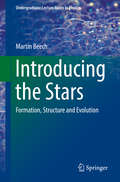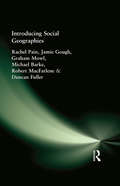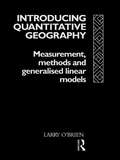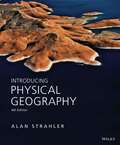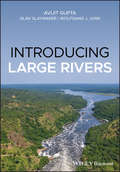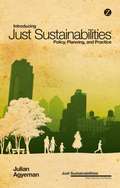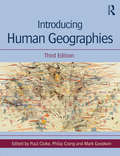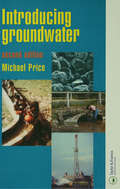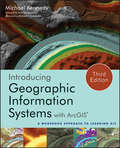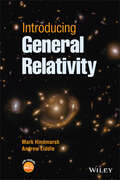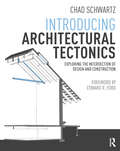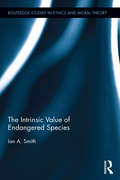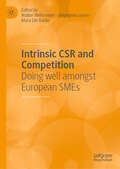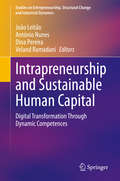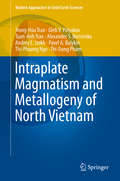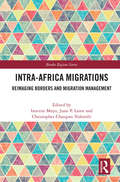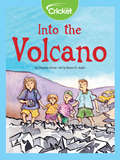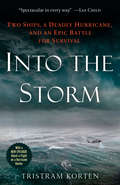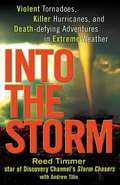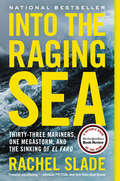- Table View
- List View
Introduction to Analytical Methods in Organic Geochemistry (Fundamentals in Organic Geochemistry)
by Jan Schwarzbauer Branimir JovančićevićAll sub disciplines in Organic Geochemistry (Petroleum Geochemistry, Environmental Geochemistry etc.) are linked by the basic analytical approaches used for identification and quantitation of individual organic substances. Hence, a fundamental prerequisite for organic geochemists is the knowledge not only about the individual analytical techniques but more about their potential as well as their limitations. In this issues basic analytical procedures and techniques are introduced comprising fundamental steps like sampling and sample storage, aspects of sample treatment like extraction and fractionation procedures and finally the specific techniques used for organic analyses on partially very low concentration levels such as mass spectrometry or infrared spectroscopy. Beside the technical aspects also application on organic-geochemical problems and the standard data evaluation practice is introduced. Finally, special chapters point to analytical pitfalls and to principal standard operation procedures. The intention of this issue is to get the readers familiar with analytical Organic Geochemistry and to enable them to assess the quality and suitability of specific analytical approaches, in particular with respect to the organic-geochemical problems.
An Introduction to Agricultural Geography
by David GriggEmploying nearly half of the world's workforce, agriculture is clearly of great economic and social importance. An incredible variety of methods are used globally; the Western world has the latest scientific and industrial advancements at its disposal, yet in the Thrid World a living is made using tools that have hardly changed in two thousand years. An Introduction to Agricultural Geography provides an extensive guide through this diverse and increaslingly important geographical subject, aiming to show that a wide range of factors explain how agricultural practices differ from place to place. Dealing with the physical environment, economic behaviour and demands, institutional and social influences and the impact of farming upon the environment, the author has produced an important introductory text that is topical, incisive and ultimately essential to reach an understanding of the remarkable diversity of the world's major industry.
Introduction to Aerosol Modelling: From Theory to Code
by David ToppingINTRODUCTION TO AEROSOL MODELLING Introduction to Aerosol Modelling: From Theory to Code An aerosol particle is defined as a solid or liquid particle suspended in a carrier gas. Whilst we often treat scientific challenges in a siloed way, aerosol particles are of interest across many disciplines. For example, atmospheric aerosol particles are key determinants of air quality and climate change. Knowledge of aerosol physics and generation mechanisms is key to efficient fuel delivery and drug delivery to the lungs. Likewise, various manufacturing processes require optimal generation, delivery and removal of aerosol particles in a range of conditions. There is a natural tendency for the aerosol scientist to therefore work at the interface of the traditional academic subjects of physics, chemistry, biology, mathematics and computing. The impacts that aerosol particles have are linked to their evolving chemical and physical characteristics. Likewise, the chemical and physical characteristic of aerosol particles reflect their sources and subsequent processes they have been subject to. Computational models are not only essential for constructing evidence-based understanding of important aerosol processes, but also to predict change and impact. Whilst existing textbooks provide an overview of theoretical frameworks on which aerosol models are based, there is a significant gap in reference material that provide training in translating theory into code. The purpose of this book is to provide readers with exactly that. In following the content provided in this book, you will be able to reproduce models of key processes that can either be used in isolation or brought together to construct a demonstrator 0D box-model of a coupled gaseous-particulate system. You may be reading this book as an undergraduate, postgraduate, seasoned researcher in the private/public sector or as someone who wishes to better understand the pathways to aerosol model development. Wherever you position yourself, it is hoped that the tools you will learn through this book will provide you with the basis to develop your own platforms and to ensure the next generation of aerosol modellers are equipped with foundational skills to address future challenges in aerosol science.
Introduction to a Renormalisation Group Method (Lecture Notes in Mathematics #2242)
by Roland Bauerschmidt David C. Brydges Gordon SladeThis is a primer on a mathematically rigorous renormalisation group theory, presenting mathematical techniques fundamental to renormalisation group analysis such as Gaussian integration, perturbative renormalisation and the stable manifold theorem. It also provides an overview of fundamental models in statistical mechanics with critical behaviour, including the Ising and φ4 models and the self-avoiding walk. The book begins with critical behaviour and its basic discussion in statistical mechanics models, and subsequently explores perturbative and non-perturbative analysis in the renormalisation group. Lastly it discusses the relation of these topics to the self-avoiding walk and supersymmetry. Including exercises in each chapter to help readers deepen their understanding, it is a valuable resource for mathematicians and mathematical physicists wanting to learn renormalisation group theory.
Introducing the Stars: Formation, Structure and Evolution (Undergraduate Lecture Notes in Physics)
by Martin BeechThis textbook introduces the reader to the basic concepts and equations that describe stellar structure. Various approximation techniques are used to solve equations, and an intuitive rather than rigorous approach is employed to interpret the properties of the stars. The book provides step-by-step instructions, helpful exercises and relevant historical lessons to familiarize students with key concepts and mathematical theories.Based upon a series of one-semester (12 weeks) elective undergraduate courses offered at the University of Regina, this book is intended for students who are interested in seeing how basic calculus and introductory physics can be applied to the understanding of the stars from their formation to their death. The text provides an intermediate stepping stone between lower-level undergraduate classes and more specialized postgraduate texts on the subject of stellar structure.
Introducing Social Geographies (A\hodder Arnold Publication)
by Rachel Pain Jamie Gough Graham Mowl Michael Barke Robert MacFarlene Duncan Fuller`Introducing Social Geographies' is a major new text offering a comprehensive and up-to-date introduction to this important area of human geography. It presents a broad overview of social geography, clearly outlining the key theoretical and political positions, and making extensive use of examples to show how these frameworks can be used to analyse real social issues.The book is ideal for undergraduates first encountering social geography and includes topic overviews, summaries of key points, critiques, boxed case studies and suggestions for further reading.
Introducing Quantitative Geography: Measurement, Methods and Generalised Linear Models
by Larry O'BrienThe purpose of quantitative geography is to train geographers in numeracy and in the vital skills of data collection, processing and interpretation. Introducting Quantitative Geography describes quantification from first principles to cover all the key elements of quantitative geography. No previous knowledge of statistical procedures is assumed. Worked examples and computer analyses are used to explain measurement, scale, description, models and modelling. Building on this, the book explores and clarifies the intellectual and practical problems presented by numerical and technological advances in the field.
Introducing Physical Geography
by Alan H. StrahlerIntroducing Physical Geography, 6th Edition is known for its clear writing, distinctive photos and illustrations and a strong supplements program. The text continues its tradition as a great book to help non-science readers visualize and understand earth processes and learn the basic language of physical geography. The new edition features a strengthened "Eye on Global Change" coverage and coverage of the geographers tool box.
Introducing Large Rivers
by Avijit GuptaAn accessible introduction to large rivers, including coverage of the geomorphology, hydrology, ecology, and environments of large river systems This indispensible book takes a structured and global approach to the subject of large rivers, covering geomorphology, hydrology, ecology, and anthropogenic environment. It offers a thorough foundation for readers who are new to the field and presents enlightening discussions about issues of management at the worldwide scale. The book also examines possible future adaptations that may come about due to climate change. The book has benefitted from contributions by Professor W.J. Junk on the ecology of floodplains and Professor Olav Slaymaker on the large arctic rivers. Introducing Large Rivers is presented in three parts. Part 1 provides an introduction to the world’s large rivers and their basins. It covers source, transfer, and storage of their water and sediment; Pleistocene inheritance; the ecology of channels and floodplains; deltas; and more. Several large rivers are discussed in the next part. These include the Amazon Mississippi, Nile, Ganga-Brahmaputra System, Mekong, and Yangtze. The last part examines changes in large rivers and our management of river systems. It studies anthropogenic alterations such as land use and deforestation in large river basins; structural control systems like dams and reservoirs on channels; and ecological changes. It finishes with chapters on the management of large rivers, covering both technical and political aspects, and the future of the world’s big river systems. Introducing Large Rivers is ideal as an introductory textbook on large rivers for future earth and environmental scientists and river managers. It will also benefit advanced undergraduate and graduate students studying geography, geology, ecology, and river management.
Introducing Just Sustainabilities: Policy, Planning, and Practice
by Julian AgyemanThis unique and insightful text offers an exploration of the origins and subsequent development of the concept of just sustainability.
Introducing Human Geographies, Third Edition
by Paul Cloke Philip Crang Mark GoodwinIntroducing Human Geographies is the leading guide to human geography for undergraduate students, explaining new thinking on essential topics and discussing exciting developments in the field. This new edition has been thoroughly revised and updated and coverage is extended with new sections devoted to biogeographies, cartographies, mobilities, non-representational geographies, population geographies, public geographies and securities. Presented in three parts with 60 contributions written by expert international researchers, this text addresses the central ideas through which human geographers understand and shape their subject. Part I: Foundations engages students with key ideas that define human geography’s subject matter and approaches, through critical analyses of dualisms such as local-global, society-space and human-nonhuman. Part II: Themes explores human geography’s main sub-disciplines, with sections devoted to biogeographies, cartographies, cultural geographies, development geographies, economic geographies, environmental geographies, historical geographies, political geographies, population geographies, social geographies, urban and rural geographies. Finally, Part III: Horizons assesses the latest research in innovative areas, from mobilities and securities to non-representational geographies. This comprehensive, stimulating and cutting edge introduction to the field is richly illustrated throughout with full colour figures, maps and photos. These are available to download on the companion website, located at www.routledge.com/9781444135350.
Introducing Groundwater
by Michael PricePresented in a style intended for the non-specialist reader, with technical terms and mathematical formulae kept to a minimum, the second edition of this introduction to groundwater covers a range of topics as they relate to hydrogeology. A major new chapter focuses on pollution.
Introducing Geographic Information Systems with ArcGIS: A Workbook Approach to Learning GIS
by Michael D. KennedyAn integrated approach that combines essential GIS background with a practical workbook on applying the principles in ArcGIS 10.0 and 10.1 Introducing Geographic Information Systems with ArcGISintegrates a broad introduction to GIS with a software-specific workbook for Esri's ArcGIS. Where most courses make do using two separate texts, one covering GIS and another the software, this book enables students and instructors to use a single text with an integrated approach covering both in one volume with a common vocabulary and instructional style. This revised edition focuses on the latest software updates—ArcGIS 10.0 and 10.1. In addition to its already successful coverage, the book allows students to experience publishing maps on the Internet through new exercises, and introduces the idea of programming in the language Esri has chosen for applications (i.e., Python). A DVD is packaged with the book, as in prior editions, containing data for working out all of the exercises. This complete, user-friendly coursebook: Is updated for the latest ArcGIS releases—ArcGIS 10.0 and 10.1 Introduces the central concepts of GIS and topics needed to understand spatial information analysis Provides a considerable ability to operate important tools in ArcGIS Demonstrates new capabilities of ArcGIS 10.0 and 10.1 Provides a basis for the advanced study of GIS and the study of the newly emerging field of GIScience Introducing Geographic Information Systems with ArcGIS, Third Edition is the ideal guide for undergraduate students taking courses such as Introduction to GIS, Fundamentals of GIS, and Introduction to ArcGIS Desktop. It is also an important guide for professionals looking to update their skills for ArcGIS 10.0 and 10.1.
Introducing General Relativity
by Mark Hindmarsh Andrew LiddleIntroducing General Relativity An accessible and engaging introduction to general relativity for undergraduates In Introducing General Relativity, the authors deliver a structured introduction to the core concepts and applications of General Relativity. The book leads readers from the basic ideas of relativity—including the Equivalence Principle and curved space-time—to more advanced topics, like Solar System tests and gravitational wave detection. Each chapter contains practice problems designed to engage undergraduate students of mechanics, electrodynamics, and special relativity. A wide range of classical and modern topics are covered in detail, from exploring observational successes and astrophysical implications to explaining many popular principles, like space-time, redshift, black holes, gravitational waves and cosmology. Advanced topic sections introduce the reader to more detailed mathematical approaches and complex ideas, and prepare them for the exploration of more specialized and sophisticated texts. Introducing General Relativity also offers: Structured outlines to the concepts of General Relativity and a wide variety of its applications Comprehensive explorations of foundational ideas in General Relativity, including space-time curvature and tensor calculus Practical discussions of classical and modern topics in relativity, from space-time to redshift, gravity, black holes, and gravitational waves Optional, in-depth sections covering the mathematical approaches to more advanced ideas Perfect for undergraduate physics students who have studied mechanics, dynamics, and Special Relativity, Introducing General Relativity is an essential resource for those seeking an intermediate level discussion of General Relativity placed between the more qualitative books and graduate-level textbooks.
Introducing Architectural Tectonics: Exploring the Intersection of Design and Construction
by Chad SchwartzIntroducing Architectural Tectonics is an exploration of the poetics of construction. Tectonic theory is an integrative philosophy examining the relationships formed between design, construction, and space while creating or experiencing a work of architecture. In this text, author Chad Schwartz presents an introductory investigation into tectonic theory, subdividing it into distinct concepts in order to make it accessible to beginning and advanced students alike. The book centers on the tectonic analysis of twenty contemporary works of architecture located in eleven countries including Germany, Italy, United States, Chile, Japan, Bangladesh, Spain, and Australia and designed by such notable architects as Tadao Ando, Herzog & de Meuron, Kengo Kuma, Olson Kundig, and Peter Zumthor. Although similarities do exist between the projects, their distinctly different characteristics – location and climate, context, size, program, construction methods – and range of interpretations of tectonic expression provide the most significant lessons of the book, helping you to understand tectonic theory. Written in clear, accessible language, these investigations examine the poetic creation of architecture, showing you lessons and concepts that you can integrate into your own work, whether studying in a university classroom or practicing in a professional office.
The Intrinsic Value of Endangered Species (Routledge Studies in Ethics and Moral Theory)
by Ian A. SmithWhy save endangered species without clear aesthetic, economic, or ecosystemic value? This book takes on this challenging question through an account of the intrinsic goods of species. Ian A. Smith argues that a species’ intrinsic value stems from its ability to flourish—its organisms continuing to reproduce successfully and it avoiding extinction—which helps to demonstrate a further claim, that humans ought to preserve species that we have endangered. He shows our need to exercise humility in our relations with endangered species through the preservation of their intrinsic goods, which in turn rectifies our degradation of their importance. Unique in its appeal to virtue ethics and to species concepts, The Intrinsic Value of Endangered Species is an important resource for scholars working in environmental ethics and the philosophy of biology.
Intrinsic CSR and Competition: Doing well amongst European SMEs
by Mara Del Baldo Walter Wehrmeyer Stéphanie LooserThis edited book is at the intersection of the discussion on family-owned business, the CSR agenda and company competition in Europe. The authors contribute to the debates on corporate social responsibility by arguing that formal management systems are not the one-size-fits-all solution they are typically presented to be. Exploring alternative interpretations of the profile environmental management activities have in SMEs, the book evaluates the way in which cultural and ethical values are embedded in European SMEs in order to drive and orientate CSR successfully without following the mainstream ‘systems’ approach. It addresses several values of thought within the CSR debate such as intrinsic CSR, the role of virtue ethics and moral theory in corporate culture, environmental sustainability and vision-driven CSR. Focusing on a European perspective, the book heuristically explores an alternative model for the integration of CSR, innovation dynamics and economic success driven by intrinsic values rather than extrinsic post-decision rationalisations.
Intrapreneurship and Sustainable Human Capital: Digital Transformation Through Dynamic Competences (Studies on Entrepreneurship, Structural Change and Industrial Dynamics)
by João Leitão Veland Ramadani António Nunes Dina PereiraThis book elaborates on the combined challenges regarding intrapreneurship, sustainability of human resources management (HRM) and digital transformation faced by today’s organizations. Representing the first such attempt in current management literature, it explores the sustainable HRM approach, which focuses on connecting internal and external factors so as to achieve positive outcomes not only for the respective organization but also for the society, economy, and environment. It also discusses cases related to HRM’s role in establishing a corporate sustainability culture, while also working to promote employee engagement, satisfaction, performance and well-being. In closing, the book discusses the new opportunities provided by digitalization and connectivity in the field of intellectual capital, which make employees the central focus of the organization in order to create sustainable competitive advantages.
Intraplate Magmatism and Metallogeny of North Vietnam
by Thi-Dung Pham Thi-Phuong Ngo Pavel A. Balykin Andrey E. Izokh Alexander S. Borisenko Tuan-Anh Tran Gleb V. Polyakov Trong-Hoa TranThis book by Vietnamese and Russian authors is the first of its kind and combines the extensive knowledge on the petrology and metallogeny of the late Paleozoic - early Mesozoic and Cenozoic periods in North Vietnam. The Permian - Triassic and Paleogene volcano-plutonic and plutonic associations are two important geological events in the evolutionary history of Southeast Asia, including the 260 - 250 Ma Emeishan mantle plume and Indian-Eurasia collision at 60 - 55 M. The volume includes 9 chapters, divided into 3 parts. Part 1 introduces the geological structure of North Vietnam; Part 2 covers the Permian - Triassic magma associations and metallogeny; and Part 3 focuses on the Cenozoic magma associations and metallogeny. In each chapter, the geological setting of magmas, classification of different geological structures, and composition characteristics, such as mineralogy, geochemistry, isotope systematics and geochronology are discussed. This book represents an important reference document for international and Vietnamese geologists engaged in the geological history and metallogeny of Vietnam, an important area of the Asian continent. The monograph also has a practical significance in contributing new premises and to assess rare and precious mineral prospects. In addition, it can be regarded as a necessary data base for petrological and metallogenic projects and university courses.
Intraplate Earthquakes
by Pradeep TalwaniIntraplate earthquakes occur away from tectonic plate boundaries: their locations are difficult to predict, risking huge damage and loss of life. The 2001 Bhuj earthquake (featured in this book) was the largest intraplate earthquake for three decades and has provided unique insight into these events. This cutting-edge book brings together research from international leading experts in the field. Each chapter provides a comprehensive review of these earthquakes in a different global location, ranging from Australia, China, India and the Sea of Japan, to Western Europe, Brazil, New Madrid (Central USA), and Eastern Canada. They explore similarities and differences between regional features and the mechanical models required to explain them, as well as assessing geophysical techniques used to investigate them. Providing the first global overview of intraplate earthquakes, this is an essential book for academic researchers and professionals in seismology, tectonics, tectonophysics, geodesy, structural geology, earthquake dynamics, geophysics, and structural engineering.
Intra-Africa Migrations: Reimaging Borders and Migration Management (Border Regions Series)
by Inocent MoyoThis book discusses regional and continental integration in Africa by examining the management of migration across the continent. It examines borders and securitisation of migration and the challenges and opportunities that arise out of reconfigured continental demographics. The book offers insights on intra-Africa migrations and highlights how intra-continental migration creates socio-economic and cultural borders. It explores how these borders, beyond the physical boundaries of states, including the Berlin Conference-constructed borders, create cultural divides, challenges for economic integration and cross-border security, and irregular migration patterns. While the movement of economic goods is valued for regional economic integration, the mobility of people is seen as a threat. This approach to migration contradicts the intentions of true integration and development, and triggers negative responses such as xenophobia that cannot be addressed by simply managing the physical border and allowing free movement. This book engages in a pivotal discussion of these issues, which are hitherto missing in African border studies, by demonstrating the ubiquity and overreaching influence of various kinds of borders on the African continent. With multidisciplinary contributions that provide an in-depth understanding of intra-Africa migrations and strategies for enhanced migration management, this book will be a useful resource for scholars and students studying geography, politics, security studies, development studies, African studies and sociology.
Into the Volcano
by Charnan SimonDid you know that Hawaii is still being built, even today? Heidi learns all about how Kilauea, the most active volcano in the world, erupts and spills more lava every day, making the island grow! She also gets to visit Mauna Loa, the biggest mountain in the world. What do you think it might be like to visit?
Into the Storm: Two Ships, a Deadly Hurricane, and an Epic Battle for Survival
by Tristram Korten“An intense, immersive deep dive into a wild, dangerous, and unknown world, written with the pace and appeal of a great thriller. This is nonfiction at its very best.”—Lee ChildThe true story of two doomed ships and a daring search-and-rescue operation that shines a light on the elite Coast Guard swimmers trained for the most dangerous ocean missions In late September 2015, Hurricane Joaquin swept past the Bahamas and swallowed a pair of cargo vessels in its destructive path: El Faro, a 790-foot American behemoth with a crew of thirty-three, and the Minouche, a 230-foot freighter with a dozen sailors aboard. From the parallel stories of these ships and their final journeys, Tristram Korten weaves a remarkable tale of two veteran sea captains from very different worlds, the harrowing ordeals of their desperate crews, and the Coast Guard’s extraordinary battle against a storm that defied prediction. When the Coast Guard received word from Captain Renelo Gelera that the Minouche was taking on water on the night of October 1, the servicemen on duty helicoptered through Joaquin to the sinking ship. Rescue swimmer Ben Cournia dropped into the sea—in the middle of a raging tropical cyclone, in the dark—and churned through the monstrous swells, loading survivors into a rescue basket dangling from the helicopter as its pilot struggled against the tempest. With pulsating narrative skill in the tradition of Sebastian Junger and Jon Krakauer, Korten recounts the heroic efforts by Cournia and his fellow guardsmen to haul the Minouche’s crew to safety. Tragically, things would not go as well for Captain Michael Davidson and El Faro. Despite exhaustive searching by her would-be rescuers, the loss of the vessel became the largest U.S. maritime disaster in decades. As Korten narrates the ships’ fates, with insights drawn from insider access to crew members, Coast Guard teams, and their families, he delivers a moving and propulsive story of men in peril, the international brotherhood of mariners, and the breathtaking power of nature.Advance praise for Into the Storm “An incredible story and first-rate adventure . . . Tristram Korten delivers us into a thrilling and dangerous world, strapping us in beside everyday heroes who confront forces of nature even Hollywood can’t re-create.”—Robert Kurson, New York Times bestselling author of Shadow Divers “A terrifying but also inspiring story of disaster and resilience on the high seas . . . riveting stuff.”—Josh Dean, author of The Taking of K-129
Into the Storm
by Reed TimmerReed Timmer, a star of the top rated Storm Chasers on the Discovery Channel is one of the most successful and most extreme storm chasers in the world. His is a job that requires science and bravado, knowledge and instinct just to survive, never mind excel. Now, in Into the Storm, he takes readers inside the terrifying and awe- inspiring world of big weather. Published to coincide with the fourth season's premiere, Into the Storm is Timmer's dramatic account of his extraordinary profession. Featuring stories of the three-hundred- plus extreme tornados, hurricanes, or blizzards that Timmer has watched ring-side over the last decade-storms that include the killer F5 tornado that struck Moore, Oklahoma, in May 1999; the unprecedented, devastating storm surge of Hurricane Katrina; and the little-studied but enormously powerful storm systems in places like Canada and Argentina. As a Ph. D. candidate in meteorology, Timmer is after more than just an adrenaline rush-his stories feature fascinating insights into the science of storms, and how the data he is collecting will could possibly save lives. With a firsthand perspective on the storm-chasing community, Timmer also takes readers inside this world, examining his controversial obsession and the ethical debates it sparks. Featuring the same you-are-there immediacy that attracts hundreds of thousands of visitors to Timmer's web site tornadovideos. net, every month, Into the Storm is one wild-and informative-ride. Watch a Video .
Into the Raging Sea: Thirty-Three Mariners, One Megastorm, and the Sinking of El Faro
by Rachel SladeOn October 1, 2015, Hurricane Joaquin barreled into the Bermuda Triangle and swallowed the container ship El Faro whole, resulting in the worst American shipping disaster in thirty-five years. No one could fathom how a vessel equipped with satellite communications, a sophisticated navigation system, and cutting-edge weather forecasting could suddenly vanish—until now. <p><p> Relying on hundreds of exclusive interviews with family members and maritime experts, as well as the words of the crew members themselves—whose conversations were captured by the ship’s data recorder—journalist Rachel Slade unravels the mystery of the sinking of El Faro. As she recounts the final twenty-four hours onboard, Slade vividly depicts the officers’ anguish and fear as they struggled to carry out Captain Michael Davidson’s increasingly bizarre commands, which, they knew, would steer them straight into the eye of the storm. Taking a hard look at America's aging merchant marine fleet, Slade also reveals the truth about modern shipping—a cut-throat industry plagued by razor-thin profits and ever more violent hurricanes fueled by global warming. <p> A richly reported account of a singular tragedy, Into the Raging Sea takes us into the heart of an age-old American industry, casting new light on the hardworking men and women who paid the ultimate price in the name of profit.
